“These kids today with their collector numbers and their newfangled tap symbol. Twenty Black Lotuses and twenty Plague Rats. Now that’s real Magic.”
When I write, I don’t always write ‘in order.’ The introduction isn’t always first. The introduction has always been the easiest part. Not this time. I watched all the Vintage Super League play-in tournament videos again, I wrote an analysis of my games, I added in commentary about playing, my journey in getting better, and what the future could hold, if I work for it. I have provided links for all the videos (the article is best if the videos are seen first). There was still the matter of that introduction though…
When you know the ending, and the ending did what this ending did to me, it’s tough to focus on the journey. But life is in the journey. Life can’t only be about the destination; we spend so little time there before it’s time to move on to the next thing, and the time that we spend getting to that point, the actual journey itself, comprises most of our time here. Enjoying the process isn’t always easy, but it’s necessary. There are lessons to be learned. There are silver linings in failed ventures, and tournaments lost. That sting that I felt lost its power as the days passed. In its place, I found the fire to really play again, and to aim to play my best. This can be the platform for something more, something better.
There were many, many positive experiences that I had in participating in the Vintage Super League play-in tournament. When I left my mental fallout shelter, it was because I reflected on all of those things, and they helped remind me why I love this format, this game, and this community.
I said to friends before the event started that this was the Murderer’s Row of lineups (and no, I wasn’t counting myself in that list). We had a Hall of Famer, Pro Tour greats, and some of the most accomplished, exciting players in the game today. I am a format specialist. I stopped playing Limited in 2008. I haven’t played Standard since 2003. I play Vintage, or I don’t play.
I wanted the tough competition. I hoped that I would be able to show that I was capable of hanging with these guys, when they played the format I loved. I didn’t know why there was a six underneath Sam Black’s picture. I later found out it was because he was the sixth highest ranked player in the world at the time. The road was going to be difficult. But there was joy there. Challenges are opportunities to show that we can rise above, conquer what’s in front of us, and move on. Losses are opportunities to learn from our errors, and become better than we were.
Ab Initio
Sam Black
Here was the deck that I expected. Round one, Mentor. Your opponent is on the most prolific, and most successful Vintage deck since Chalice of the Void’s restriction. He is the 800 pound gorilla in the room, and he’s coming for you. Are you ready?
One of the beautiful, and terrifying, aspects of Vintage is that even in the matches where you’re favored, sometimes things can go very, very wrong, very, very quickly. Monastery Mentor is an incredible card; Mentor’s ability to quickly turn the tide cannot be underestimated. A turn one Mentor, followed with nearly anything, could put me far enough behind that I would never be able to meaningfully interact with Sam.
My opener, on the draw, was:

Sam’s main features four Mental Missteps and, because he was on the play, a Spell Pierce that is potentially very live against that hand. He has five answers to Sol Ring, all of which crush that hand. This hand is unkeepable.
My second hand was more powerful, albeit just as risky:
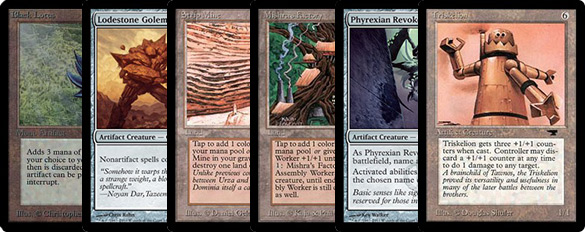
With the scry from the mulligan, I saw Mox Emerald.
This hand is all-in on a turn one Lodestone Golem. If Sam has Force of Will, I don’t even have a solid mana base to continue casting threats.
But the hand has turn one Lodestone Golem. Oh, and turn one Strip Mine. Sometimes you have to gamble that they don’t have the Force of Will (or the Swords to Plowshares in this match). The Lodestone should be cast immediately; if you give your opponent the opportunity to see more cards off his draw, or anything he may cast once you pass the turn back to him, you potentially grant him the answer he requires for your Lodestone.
When Sam cast Brainstorm in response to Strip Mine, I didn’t think there was a shot in hell that the Lodestone was going to resolve. When it did, I thought he had found a Swords to Plowshares, or the mana to cast it, having already had it in hand. When I used my Wasteland to hit one of Sam’s Tundras, I said “Swords in response” to my computer screen. Thankfully, I was wrong.
I sideboarded out:
-1 Sword of Fire and Ice
-1 Mox Emerald
-1 Mishra’s Factory
-2 Hangarback Walker
I sideboarded in:
+2 Karakas
+3 Dismember
I wanted to keep the third Sword of Fire and Ice, but it wasn’t an easy call. Mentor is the critical card of this match, and answering Mentor means that all three Dismembers have to come in. Jace, Vryn’s Prodigy, Kataki, War’s Wage and Stony Silence are all solid reasons to board in Karakas. Cards have to come out, and while I toyed with the idea of boarding out Chalice, Chalice isn’t just something to be cast on the first turn to nerf his artifact mana. Chalice of the Void on one shuts off Swords to Plowshares, which is another tremendous card for him in this match. Two Dack Faydens may not seem like much, but Dack stealing a Hangarback Walker was a particularly nasty consideration. Hangarback Walkers came out specifically because of opposing Dacks.
My opening hand for game two:
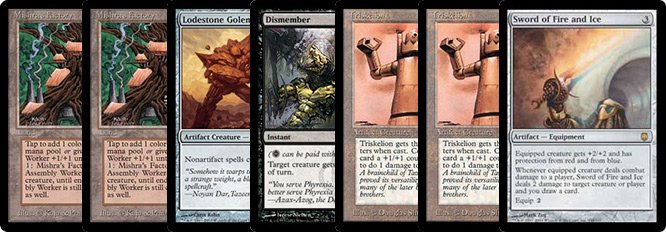
Hands like this happen with Shops. Sometimes they happen more frequently than you’d like. Without mana to cast the top end of my curve, or the cheap threats to put early pressure on his life total, I knew immediately that it was time to mulligan again.
My hand of six was a marked improvement:
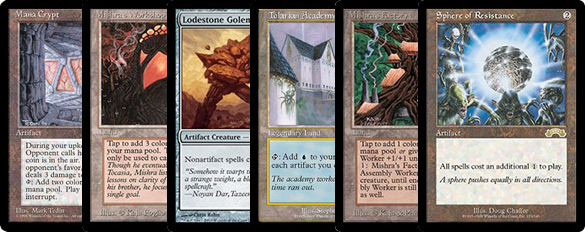
This hand is far, far better.
I considered opening up with Mana Crypt, Sphere of Resistance, Mishra’s Factory, but this line of play forgets my role in the match. One of the greatest Magic articles ever written is Mike Flores’ “Who’s the Beatdown?” (if you haven’t read it yet, read it. If you have, read it again). In this match, unquestionably, I am the beatdown; long games do not favor me. If I give Sam time, he will find mana, or Mentors, or the permission he needs to counter the critical spell of the match. The long-game does not favor me, as his ability to generate an army of monks is something that I will not be able to beat.
This time around, Sam did have the Force of Will for Lodestone Golem.
While Sam did have the Force of Will for Lodestone Golem, Triskelion would resolve to kill his Jace, Vryn’s Prodigy, and the sole Sphere of Resistance on the board, combined with his Stony Silence, would choke his ability to easily cast his spells. Gush decks, albeit URx Delver, or Gush-Mentor run a light mana count, making cards like Sphere of Resistance and Thorn of Amethyst that much more powerful.
While my clock of Arcbound Ravager and Mishra’s Factory was slower than I’d have liked, it proved to be enough, and eventually a Lodestone Golem joined the fray and ended the match.
I was on to the next round.
O Amice, Vir Bonus Est
Roland Chang
Roland Chang is the only individual to ever be the reigning Vintage Champion and Legacy Champion at the same time. On top of being one of the greatest Vintage pilots around, Roland is a close friend. Before the event, I hoped that if I didn’t win, Roland would. I didn’t want to have to play against Roland, not because I thought I’d play poorly, or that the match wasn’t favorable, but because Roland is one of the true champions of the format, and a great friend. If I lost this round, I was going to be OK with it.
My opener against Roland in our first game was strong:
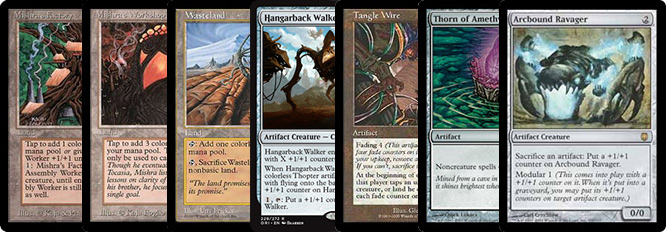
Game one was a pitched battle where I was able to save the Hangarback Walker until I knew it would resolve. Roland had already spent two of his Force of Wills, one countering a Thorn, the second countering a Tangle Wire, but the commentators forgot that Roland had revealed Lightning Bolt to flip Delver of Secrets. With only two cards in hand, I knew that Roland couldn’t have his third Force of Will and a blue card, and that the Hangarback Walker was safe.
While I don’t want to put myself in a position where a flipped Delver of Secrets and a Lightning Bolt or two can end the game, I knew that if needs be, the Delver would never hit me again. I didn’t mind taking some extra damage with the Ancient Tomb to generate an additional counter, as if Roland decided to attack with his Delver, I’d be able to sacrifice the Hangarback Walker for three tokens, pumping the Ravager, blocking the Delver, and then sacrificing the Thopter token before the damage killed it. The game was over at that point.
In the second game, I opened with:
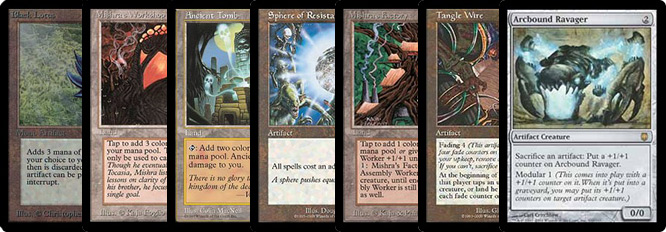
I was very happy with this opener. It has immediate pressure on his spells with the Sphere of Resistance, a Tangle Wire to buy me several turns, and pressure with both an Arcbound Ravager and a Mishra’s Factory. This hand is not a hand that may seem incredibly powerful at first glance, but it is. When I drew a Workshop on my first draw step, I knew I was going to be in business all game long. Again, there are games where Shop players are constrained on their mana, and they are difficult games to win.
With this hand, I knew that no matter what I drew, I’d be able to play it immediately. Additionally, on the back of the mana advantage of Mishra’s Workshop(s), I knew that I would eventually force him into a position where he needed to answer multiple threats per turn (either to his life total, or his mana base). Grixis Pyromancer isn’t built for that fight. There is the risk that I flood, but it’s one I happily accepted.
In this match, I made my first two mistakes of the tournament. Both errors came on the same turn. With a fresh Tangle Wire in play, I had a Wire in play with one counter. On my turn, it would fade down to zero, and become fodder to tap down to the new Wire. My logic in not sacrificing the old Wire to the Ravager for an extra point of damage was that in my following turn, knowing that I wanted to attack with Mishra’s Factory, keeping the old Wire around guaranteed that I would be able to untap with both Mishra’s Workshops, enabling me to cast every threat in my deck.
While this is true, this train of thought fails to account for the board state that I was in. I was in a race. I had all the tools that I needed to end the game, and I needed to just end the game. Every life point that I gave back to Roland was time that he would be able to use against me. Untapping a second Mishra’s Workshop would have been nice, but I didn’t need more to win. That life point mattered.
The second mistake is one that I had to have pointed out to me the following day. As a Shop-Prison pilot for the last 12 years, I do not have as much experience with Shop-Aggro as many others. As such, the layers of Arcbound Ravager were initially lost on me. In that board state, if I had sacrificed my first Arcbound Ravager to my second, two things would happen:
1. My second Arcbound Ravager would net a modular counter for having an artifact sacrificed to it.
2. My first Arcbound Ravager, upon hitting the graveyard, would put a modular counter on my Phyrexian Revoker.
This is a flat-out mistake on my part. I missed an extra two points of damage in that game, and I am lucky that it did not come back to punish me.
This was also a harbinger of things to come. I know that I need a considerable amount of work with Arcbound Ravager. I need to re-evaluate how I play with this card, how I value it, and when it’s at its zenith, or nadir in given board-states.
Hannibal ad Portas
Reid Duke
The day before I was set to play Reid, I found myself listening to Switchfoot, and one of my favorite songs came up:
“I’ve been watching the skies
They’ve been turning blood red
Not a doubt in my mind anymore
There’s a storm up ahead
Hello hurricane
You’re not enough
Hello hurricane
You can’t silence my love
I’ve got doors and windows
Boarded up
All your dead end fury is
Not enough
You can’t silence my love, my love…”
It put things in perspective. It gave me hope. No matter what happened in my match against Reid, I wasn’t going to let the result change the love that I felt for the format and the community. I knew that this match, more than any other, would depend on who was on the play, and the quality of my opening hand. On top of being one of the best players on the planet, Reid was playing one of the fastest, most powerful decks in Vintage.
Still, with all the games that I had under my belt, I felt prepared. I would fight this storm, and I thought I would win.
I drew the best hand I’d drawn all tournament in my first game against Reid, and I won the die roll. It was impossible to ask for more than that. I had everything, from all the mana I’d need all game, to all the prison pieces I’d need to lock him out, to a clock that, while not lightning-fast, was fast enough. I even drew a Strip Mine to ensure that he wouldn’t be able to remove a Simian Spirit Guide, fetch a blue source and Hurkyl’s me on his turn.
Game two, however, had some controversial decisions.
I sideboarded out:
-1 Hangarback Walker
-3 Sword of Fire and Ice
-2 Triskelion
I sideboarded in:
+3 Tormod’s Crypt
+3 Porcelain Legionnaire
Time matters. While Swords and Trikes are excellent against many of the prominent decks in the field, they take a large mana investment (six mana and five mana, respectively) before you get any value out of them, and I knew I wouldn’t have much time for that. Machine-gunning an opponent out with Arcbound Ravager/Triskelion was great in theory, but in my test games I was almost always dead before that mattered (it happened once in 50+ games). The extra turn or two that I’d potentially need to use either of them was not guaranteed to me. I needed fast hands and quick threats to immediately attack his life total.
In the two weeks leading up to my match against Reid on December 8th, I got as many games against his list as I could. I was lucky to have friends who were willing to give me a seemingly endless number of games. David Ata, Mike Lupo, and Shawn Anthony helped tremendously there. New England’s Storm master, Jesse Martin, gave me a heads up on what he thought Reid’s boarding strategy would look like.
Storm’s life total is a resource. Cards like Necropotence and Yawgmoth’s Bargain are powerful, but if your opponent is on a low life total, they are, obviously, far less so.
I didn’t have the eighth Sphere in the sideboard. I could have used it here. I had to make do with what I had.
In any match, you need to diagnose which cards you can beat, and which cards beat you. If you’re a Dredge pilot, you know that Grafdigger’s Cage is usually just a temporary imposition. Multiple Tormod’s Crypts is something else entirely. I knew that Reid’s fifth bounce effect, a Rebuild, was something that I might be able to push out to the point of being uncastable. Hurkyl’s Recall was something different, and far more deadly. Not only did Reid have two Hurkyl’s Recalls in his main deck, he had another two in the sideboard. Where he also happened to have four basic lands. And three Simian Spirit Guides. Reid came ready to fight.
In the play-test games that we played, Hurkyl’s Recall proved to be just as critical as I thought it would be. Sometimes I was able to force him to defensively Hurkyl’s Recall, but more often than not, his Hurkyl’s Recalls were offensive, and preceded a lethal Tendrils of Agony.
If I was going to beat Reid, I knew that I needed a certain kind of hand. I needed the ability to generate four mana in the first two turns, which meant that I almost always needed an Ancient Tomb or Mishra’s Workshop. I needed at least one Sphere effect, and another piece of serious disruption (Wasteland and Phyrexian Revoker didn’t really count). I needed a clock. I had to have at least five points of damage on him by turn two. Without those things, I ended up in protracted games in which I finally died to Hurkyl’s Recall.
Finally, there was something that I took for granted. In the blue match, a Storm pilot will typically save their artifact mana to generate more storm. In all the games that I played against Anthony, Ata, and Lupo, they played their artifact mana as fast as they could, in order to put Hurkyl’s Recall online as fast as possible. I expected Reid to do the same, and given that he didn’t have a chance to interact with me in the first game, I had no further information on his play style.
My opener for game two was:
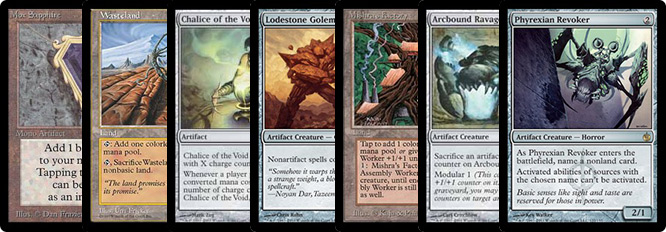
This hand is fool’s gold. In the blind, this hand allows Reid to play all his artifact mana, and it can’t defend against a Hurkyl’s. He has brought in four basic lands, so I can’t expect to get value out of Wasteland, and even if I could, I have further handicapped my mana. Yes, I had draw steps, but as a player without a draw engine, I can’t rely on the top of my deck to give me what I need. Sometimes you just clunk. On a hand of seven, I want better. There was some debate about this hand, but I feel confident in my decision to mulligan it.
While the hand of seven being mulliganed generated some controversy with the chat and the broadcasters, the hand of six was a tougher decision for me:
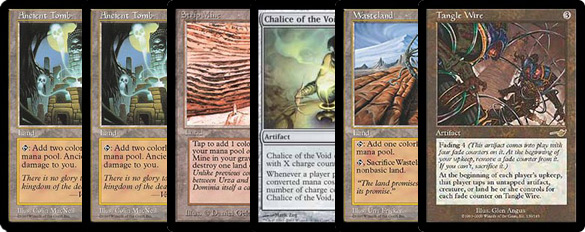
This hand violates the rule of having pressure on Reid, and it also violates the rule about having a Sphere effect, but with Strip Mine, I know I’ll hit one of Reid’s basics. With Tangle Wire and Wasteland, I know that there is a good chance that I’ll be able to hit one of his fetches. Chalice of the Void on one is a good, albeit not great play, but it’s a means of interacting with him on my first turn.
Still, there was no Sphere, and no real pressure. While there is some debate here as well, I was happy with my decision to mulligan this hand. Until I saw my hand of five:
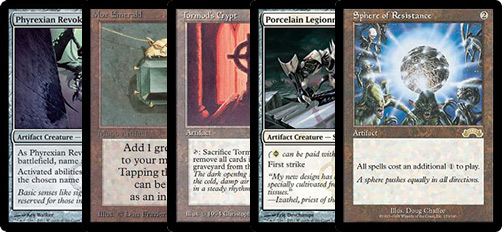
Well, I had found a Sphere. Too bad that there was no mana to cast it. This hand was terrible. It was at this point that I knew that I would have to mulligan to four, and that there was very, very little chance that I would be able to pull through with a hand of four. I was already preparing for game three. My hand of four:
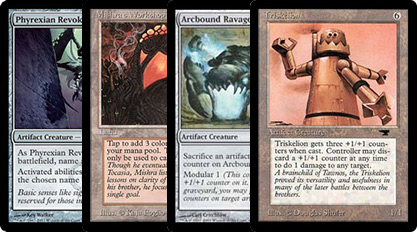
I have mana, I have two ‘threats’ I can play, and I can’t go further down. This game involved several strong top-decks, including the miraculous Trinisphere, in addition to a very strong Tangle Wire and a stronger Wasteland on Reid’s Bloodstained Mire. Somehow, I managed to keep Reid off blue, and in saving his artifact mana for storm, he never had Hurkyl’s Recall online. Luck favored me in this game, without a doubt. Winning against Storm, on the draw, on a hand of four, when your opponent is Reid Duke is about as ridiculous as it comes. If you had asked me after I kept my hand of four, I don’t think I’d have given myself a 5% chance of winning this game.
The sole interesting in-game call (for me) was whether or not to sacrifice both Moxen to my Ravager, or only one. This brings up an interesting point; in having all four Lodestones left in my deck, there was a moderate chance that I drew one of them. If I did, by sacrificing both Moxen, I denied myself the ability to cast it.
When you play against Storm, their life total isn’t just a life total, but a prospective number of additional cards in their hand. The Moxen that I sacrificed weren’t points of damage to me, they were cards in Reid’s hand. If I had hit a Lodestone Golem instead of a Trinisphere, I would have felt exceptionally vulnerable. Reid would have been able to play his Mana Crypt and Mana Vault, and, as this match is defined by Hurkyl’s Recall, I would have expected to have been bounced. As it turned out, Lodestone would have ended the game anyways, but I think it’s wrong to look at this as a black or white decision. I felt like I needed to hit a Sphere of Resistance, Thorn of Amethyst, or Tangle Wire to potentially win this game. It may be wrong to sacrifice the extra Mox, but this was a judgement call, not an outright error. Given that I already thought that Reid was saving his fast mana for storm (which he was), and had considered that he was holding a Waste-able land in hand that he needed (like Underground Sea), and didn’t want to play to ensure its survival, I didn’t think that Lodestone would save me. Honestly, I thought that my only shot to win that game was to hope that the Wasteland on Reid’s Bloodstained Mire kept him off the necessary blue for Hurkyl’s Recall, and that I would draw the critical Sphere that I so desperately wanted in order to punish him for saving his fast mana for storm. Without knowing Reid’s hand, I don’t know that Lodestone is likely a game-ender. His style of play led me to believe otherwise.
In Walter Isaacson’s Steve Jobs biography, many Apple employees are quoted as saying that Jobs possessed a ‘reality distortion field’; that he was able to convince those around him that impossible things were possible. The great Magic players (and Reid is absolutely one of the greats) possess something like this in-game. Their ability to lead you astray, to convince you that their hand is something other than what it is, is tremendously powerful. You will lead your opponent to play a less efficient game, forcing them to surrender the quickest route to victory in order to play what they deem to be the ‘best’ or ‘safest’ route. When it comes to the Mox play, I played like Reid had the Hurkyl’s Recall, because that’s what would beat me. If he didn’t have it, I was on the path to victory; if he did, I needed to do all I could to ensure that it was the least valuable/powerful Hurkyl’s Recall possible.
We sat for what felt like an eternity, waiting for the ‘go’ from the producer. This was important; in having to wait, both Reid and I were able to make our mulligan decisions before we were given the OK to play. When we got that OK, priority was passed back to me very quickly. Right or wrong, I thought that Reid had a strong hand based on the speed with which priority was passed. When he opened on a mere Bloodstained Mire, I felt like I was no more than a turn or two from death. When he played a Mox Pearl to ensure that his Badlands untapped, I was more certain of it, as this play in particular felt like he telegraphed that he was saving his fast mana for storm.
Any idiot can tell you that Reid is a phenomenal player. Reid is a phenomenal player. Regardless of the outcome of the match, these two exceptionally minor things won him the war of psychology. And please note, while the match may have felt like a blowout, if Reid wins the die roll in game one, and I draw one more blank, I’m dead in both games.
In-game, I can promise you that this game felt like he was in control the entire time, allowing me to do some negligible damage before he flicked everything back to my hand and launched a lethal Tendrils of Agony at my head.
Sometimes you’ll be punished for a decision that you make in a game. Maybe it’s an in-game decision like sacrificing an extra Mox, maybe it’s a mulligan to four. You’ll have to address whether or not it was right, given the information that you had. I think the toughest thing to do in all of Magic is to make that decision again. Sometimes we’re punished for making the right play, not because it wasn’t actually right, but because even though we played to the highest percentage of victory that we could, our opponent found the outs that they needed to survive. If you ever want to be great (and I’m not claiming greatness on my part), you have to know that sometimes you have to walk down that path again, knowing that you could be punished again, in order to achieve victory.
“Once more unto the breach, dear friends, once more; Or close the wall up with our English dead.”
David Ochoa
With all the games that I had gotten in against Reid’s list and Olle’s list, I did not prepare for Ochoa’s list. I thought that I knew what I needed to know. I knew, for starters, that the most critical card in the match was Metalworker. I had to stop Metalworker at all costs, because an active Metalworker negated the tempo that I had gained with a slightly lower curve.
One of the great things that playtesting teaches us is what we don’t know. I have probably played more Shop mirrors in the last 10 years alone than nearly anyone else in the world, and in this match, that didn’t mean much. If I had tested, I’d have seen more than I already saw in diagnosing Metalworker as my problem. I’d have also come across Umezawa’s Jitte.
In 2003 I quit playing Standard. I quit right before the release of Darksteel. I was playing Broodstar Affinity, but I wasn’t having much fun, and I enjoyed Vintage too much. I missed Arcbound Ravager. A year later, I missed Jitte. I remember drafting a few times during Kamigawa block, but I did not have extensive experience playing with, or against, Jitte. It’s funny how decisions from more than a decade ago came back to haunt me in 2015. If I had continued to play Standard back then, maybe I would have gotten enough work in with Ravager to feel comfortable with it now. If I had played through Kamigawa block, maybe I’d have known that Jitte got counters when the creature dealt damage, not just when it hit an opponent. And I’d have known that Phyrexian Revoker was an answer.
I played a tight game one against Ochoa. Again, I was happy with my decisions, and the opener that I kept. It was good enough to win.
I knew that post-board, I’d be an underdog. But I knew that pre-board, I was favored. I figured that I’d likely win game one, and then I figured that I’d be able to take at least one post-board game away from Ochoa.
In game two, Ochoa played an Umezawa’s Jitte. I read the card, felt sick, and began making mistakes. Heady mistakes. The kind of mistakes that I had avoided all tournament.
To start game two, in response to Ochoa’s Lodestone, I should have played a Hangarback Walker on two. It’s a more effective use of my mana, unlike the Sword, and it also gives me time to gauge just what needed to be named with my first Phyrexian Revoker in order to blunt David’s assault. After the Jitte connected, and gained two counters, I should have immediately cast Phyrexian Revoker, and shut it off. I can’t say that I’d have known to cast the second Revoker on Triskelion (to protect the first Revoker from all but Dismember), but this line leaves me with a Hangarback Walker in play that I can pump, and a second Revoker that can be dropped once the Triskelion is cleared of counters.
That said, with the myriad errors on my behalf in that game, I don’t think that I was going to be able to come back, regardless. Had Ochoa not drawn the Dismember, I think it’s possible that I would have been able to stabilize the board if I had played flawlessly. With his Dismember, I can’t imagine a board state that I could have been working towards that would have achieved victory.
In game three, I opened with:

There is no world in which this seven is keepable. Thus, I mulled to:

This hand, too, is unkeepable. An opening hand for this deck needs at least three mana, and it needs pressure. Given Ochoa’s Wastelands, I would like more than three mana, but sometimes you don’t get what you want. Finally, I mulliganed to:

This is not a hand that you’re happy about, especially on the play. But when you’re on a hand of five, this is keepable.
Realistically, as game three went, I just did not have enough cards in hand, mana, or gas to win. I don’t think that there was anything that I could have done differently.
As a side note, while Sphere of Resistance is not optimal post-board, it is important in this match. Sphere pushes out Crucible and Metalworker; these two cards are Time Walks against his general strategy. As my curve is lower than his, it may give me the opportunity to sneak some extra damage in. As I’m the aggro deck in this match, that extra damage might seal the match.
My opening hand in the final match was:
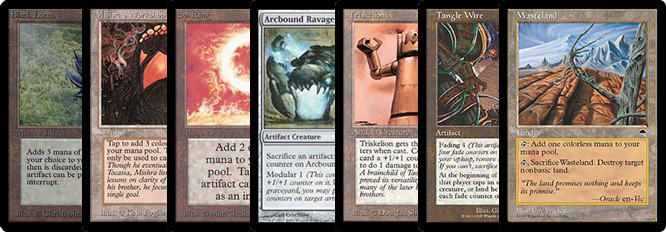
I scryed a Lodestone Golem to the top of my deck, and was happy about it.
I meant to play the Sol Ring on my first turn, and realized after the Triskelion was on the stack that I had forgotten to. While this worked to my advantage, it is an error, as I am not guaranteed to have my Mishra’s Workshop for the following turn, and I may need to use my Wasteland against an opposing land. I was lucky that Ochoa did not have a Wasteland, and that I was able to avoid the Revoker on the Sol Ring, which would have been devastating, and Wasteland Ochoa’s Mishra’s Workshop. It may have looked like a next-level play, but it was actually just a fortunate error.
I missed additional points of damage in an attack, and I should have known better. With Phyrexian Revoker (on Mox Emerald), Lodestone Golem, and Triskelion (with two counters) in play, facing an opposing 2/2 Hangarback Walker, I had the opportunity to swing with all three creatures. If I had done this, Ochoa still likely blocks the Lodestone Golem, I still have an opportunity to shoot said Lodestone Golem, and I can then follow up with the Tangle Wire in my hand while Ochoa is at six life. This turns off his mana, as he’s forced to tap it all down not to die to the opposing robot army, and puts him in an impossible situation when the Wire comes back to him set at three.
Again, I did not play optimally in this game. I got lucky in that my misplays here were small, and that they actually ended up playing to my advantage. Clearly this will not always be the case. While Ochoa managed to claw his way further back than I thought he would, given the advantages that I had in the game, I had just enough gas left in the tank to get him.
We moved on to game five, and once again I was one game away from the coveted spot in the Vintage Super League.
My opening hand in game five:

This hand has neither early threats, nor the mana to cast them. Again, I was forced to mulligan:
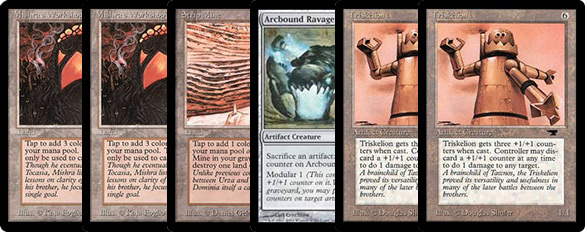
I honestly thought that this hand was going to be enough to get it done. After all the drama with Umezawa’s Jitte in game two, after the terrible hands in game three, I thought this hand would have enough to win. I was more than set on mana. I had a second turn Triskelion. I had Arcbound Ravager to power it back up after it cleared the board, and I had Porcelain Legionnaire to apply early pressure to Ochoa’s life total. And oh, by the way, I also had a Strip Mine to ensure that I would be able to hurt, and potentially cripple, Ochoa’s mana.
There was a critical point in the game where I had the opportunity to swing with a Lodestone Golem and force a trade. In looking at it now, I believe that I should have. This forces Ochoa to either trade Lodestones, or take five extra damage when I have a second Triskelion, and an Arcbound Ravager on the board. Little things add up, and this ended up being important later on. I can look back on the last six games that I played, and I can discount what I did in game two and say that I wasn’t going to come back from that. I can look to game three and say that it wasn’t competitive. But game five should have been mine. This is where I lost the event.
While Ochoa had Crucible/Waste on me, I needed to realize that Ravager/Triskelion was my path to victory. In not clearing the Lodestone Golem off Ochoa’s end of the board, or doing the extra five points of damage, I sealed my fate in this game. If he takes the extra five damage, I can machine-gun him out with Ravager/Triskelion. If he blocks my Lodestone with his, he’s unable to kill the monstrous Triskelion later on. The window was closing, and we were coming down to one game to decide everything.
My opener for the final game of the night:
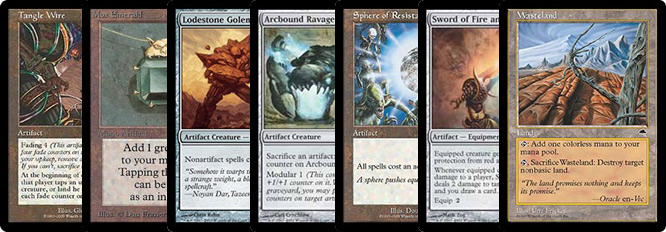
I was disappointed in seeing it. Again, I would be forced to mulligan an opener. It had nowhere near the action that I needed to start the game. I mulliganed to:
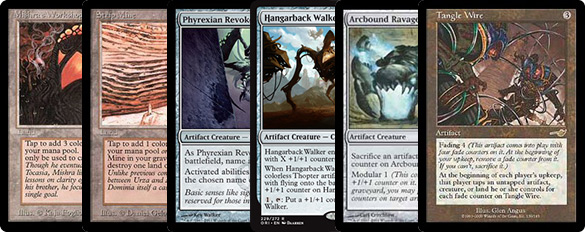
This hand is a dangerous keep. When you learn how to play Workshops, one of the first things that you learn is that you save your Workshop to cast the critical spell when you’re playing against an opponent with Wastelands. This hand can’t do that. Exposing the Workshop to land a turn one Ravager leaves me vulnerable to Wasteland, and it doesn’t put real pressure on the board. Still, on a hand of six, you have to keep this, and hope that your opponent doesn’t have the Wasteland. The hand has mana, pressure, and a Wire to potentially hold him down while you beat in for the last points of damage.
Ochoa played opened with a Mox Pearl, Chalice of the Void on zero, and Tolarian Academy, which allowed him to cast a Crucible of Worlds. At this point, my worst fears felt realized, as I felt like there was a Wasteland sitting in his hand.
That said, we need to play to the highest percentage chance to win the game, not to our fears. The right play, on my turn, was to tap the Workshop to play the Tangle Wire, and to tap the Ancient Tomb to cast the Hangbarback Walker. I am then in a board state where I can start building a Hangarback Walker up, and working towards creating a threat that is too great to counter.
If I had taken that route, I still had Phyrexian Revoker for Metalworker. I didn’t, and Metalworker finally got to punish me. I had managed to push Ochoa off Metalworker all six games so far, but I could stop him no more.
Even with that line, Ochoa would have been able to use the combination of Arcbound Ravager (sacrificing his Chalice of the Void on zero to play his Black Lotus) and Tolarian Academy (which I can never remove, thanks to his Crucible) to play Triskelion. Once he starts building up his board, Academy will allow him to cast any and all threats he draws. If the aggressive deck is going to win this game, it needs to force its opponent to stumble on their ability to play threats/blockers as it attacks for ever increasing amounts of damage. There is a window that, after a few turns, begins to rapidly close.
On one of my last draws, I drew Ancient Tomb. If I had drawn Triskelion, I would have won. Still, I can’t look at this and say that I should have drawn better that last turn. I had the match in game five, and I gave it back to him.
The game continued for a short while longer, but it was over once Ochoa’s Triskelion resolved. There was nothing that I could do.
Durate et Vosmet Rebus Servate Secundis.
Overall, I probably played at 80% or so in my games against Ochoa. There was the terrible game two, and the punt in game five. I am a better pilot than this, and yet I own this loss. Ochoa was the better Workshop pilot that night, and as things closed up for me around 12:20, I was physically exhausted and emotionally worn down. I still can’t believe that I was that close, and had to watch it all slip away.
There was a flood of support, for which I will remain eternally grateful. Thousands of people had just finished watching me play some very poor Magic, and I felt as though I had let not only myself down, but the Vintage community down.
When I woke up, the morning after, I had the same heavy, unavoidable, unmistakable feeling of shock, personal doubt and pain that I had felt the morning after the Yankees lost to the Red Sox in game seven of the 2004 American League Championship Series. For the next three days, I was in a complete mental and emotional fog. The worst loss that I had ever experienced was to Paul Mastriano in the finals of a Philadelphia Open tournament in May of 2009. But that loss didn’t sting, because less than a month later, I met Paul in the finals of a larger event at the same venue, and I beat him to win a Black Lotus.
This is different.
On the day after the Red Sox won the World Series in 2004, I got up, showered, got ready for school, and left the house. I was wearing a Yankees jersey.
I am who and what I am, with all my flaws. I cannot change the past, no matter how much I’d like to. I can prepare, I can hope for the opportunity to show that I am better than I was that night.
I was offered a spot in the play-in tournament for the Vintage Super League, and this was already a tremendous gift and honor. I will forever be grateful to Chris Pikula, Randy Buehler, Rich Shay, Dave Williams, Steve Menendian, and all who supported my bid for a place in this event. I was given an opportunity to play Vintage at its highest level, in front of an audience of thousands while some of the game’s greats commented on my hands, my lines, my games. I am now lucky enough to say that between the Vintage Super League and the 2014 Vintage Championship, Brian David-Marshall, Chris Pikula, Randy Buehler, Eric Froehlich, David Williams, Luis Scott-Vargas, David Ochoa, and Tom Martell have done commentary on my games, my matches. When I read that list of names, I think of Neutral Ground, Pro Tour Chicago, the Magic Invitational, and many of the great memories that have made Magic so important to me. To have these greats do commentary on my matches is an honor that I will always carry with me, as a lifelong fan of the game.
All I control now is my reaction to the humbling I received. I choose to grow. I choose not to let this loss define me, even if it is the toughest loss that I’ve experienced in 21 years playing this game. I choose to change the storyline.
I will test. I will learn. I will compete.
I will hope that one day, on this stage, or another, I am given the opportunity to atone for these sins.
There are still tournaments to go to. To play in. To win.
Excelsior.

